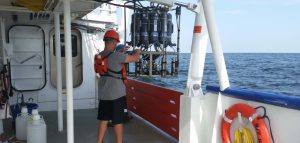Outlook incorporates multiple hypoxia models for the second year

Scientists deploy a sensor to collect water samples to test oxygen levels during the 2015 cruise to measure the size of the 'dead zone' in the Gulf of Mexico. Credit: LUMCON
Scientists forecast that this year's Gulf of Mexico dead zone --an area of low to no oxygen that can kill fish and marine life--will be approximately 5,898 square miles or about the size of Connecticut - the same range as it has averaged over the last several years.
The dead zone in the Gulf of Mexico affects nationally important commercial and recreational fisheries. Hypoxic zones or "dead zones" are caused by high levels of nutrients, and the low oxygen levels cannot support most marine life and habitats in near-bottom waters. Reducing nutrients flowing to the Gulf would help the situation since, under normal conditions, this area contains a diversity of marine life, critical habitats, and a number of key fisheries.
The NOAA-sponsored Gulf of Mexico hypoxia forecast is improving due to advancements of individual models and an increase in the number of models used for the forecast. Forecasts based on multiple models are called ensemble forecasts and are commonly used in hurricane and other weather forecasts. The ensemble of models was developed by modeling teams and researchers at the University of Michigan, Louisiana State University, Louisiana Universities Marine Consortium, Virginia Institute of Marine Sciences/College of William and Mary, Texas A&M University, North Carolina State University, and the United States Geological Survey. The hypoxia forecast is part of a larger NOAA effort to deliver ecological forecasts that support human health and well-being, coastal economies, and coastal and marine stewardship.
The confirmed size of the 2016 Gulf dead zone will be released in early August, following a monitoring survey from July 24 to August 1, conducted on a NOAA vessel and funded through a partnership between NOAA, Northern Gulf Institute, and the Louisiana Universities Marine Consortium.
 Official websites use .gov
A .gov website belongs to an official government organization in the United States.
Official websites use .gov
A .gov website belongs to an official government organization in the United States. Secure .gov websites use HTTPS
A lock or https:// means you’ve safely connected to the .gov website. Share sensitive information only on official, secure websites.
Secure .gov websites use HTTPS
A lock or https:// means you’ve safely connected to the .gov website. Share sensitive information only on official, secure websites.